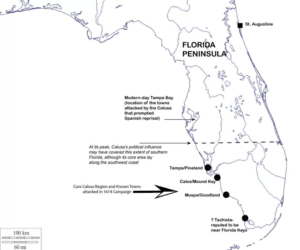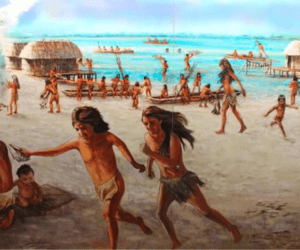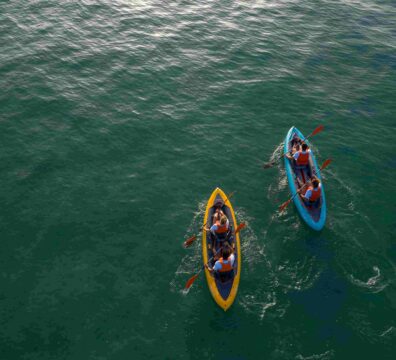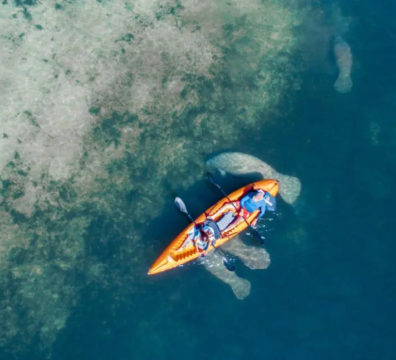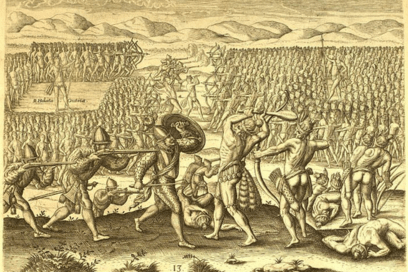The History of the Calusa Indians
- By Admin
- 31 July, 2023
The History of the Calusa Indians
The Calusa Indians were a Native American tribe that inhabited the southwestern coast of Florida for over 2,000 years. Their history is a testament to the resilience and adaptability of indigenous cultures in the face of changing environments and external influences. The rise and fall of the Calusa civilization can be divided into distinct periods that shaped their identity and contributed to their prominence in pre-Columbian Florida.
Calusa Origins and Rise to Power
- Early Origins:
The Calusa’s origins are shrouded in mystery, with limited archaeological evidence of their early existence. However, it is believed that their ancestors migrated from Central or South America into Florida around 500 BCE. Initially, they settled in the interior regions but later shifted towards the coastal areas. - Rise to Power:
By approximately 300 CE, the Calusa had established themselves along the southwestern coast of Florida. They strategically settled in regions with abundant resources, such as Charlotte Harbor, Pine Island, and the Ten Thousand Islands. These environments offered rich fishing grounds, fertile lands for agriculture, and an extensive network of waterways for transportation and communication.
The Calusa developed sophisticated canal systems, constructed from dredged oyster shells, which allowed them to navigate their dugout canoes through the maze-like mangrove forests with ease. These canals served as crucial trade routes and helped cement their position as a dominant maritime power in the region.
Calusa Societal Structure and Culture
- Social Structure and Culture:
The Calusa society was organized into chiefdoms, each led by a powerful chief known as the “Calusa King” or “Calusa Emperor.” These rulers held significant political and religious authority and were believed to have divine connections. Under their leadership, the Calusa established hierarchical social structures, with nobles, commoners, and slaves comprising the population.
Their culture was rich in artistic expression, as evidenced by intricate carvings on wood, shell, and bone. They created impressive pottery and wove intricate textiles using fibres from local plants. The Calusa religion was deeply tied to nature, and they practiced complex rituals to appease spirits and ensure successful harvests and fishing expeditions.
- Economic Practices:
The Calusa thrived on a diverse economy, which revolved primarily around fishing and agriculture. They were skilled hunters, relying on the abundant marine life and wildlife in the region. Fish, shellfish, and manatees provided sustenance, while deer, small mammals, and birds supplemented their diet.
Agriculture played a crucial role in their survival, and they cultivated crops such as maize (corn), beans, squash, and various fruits. Their agricultural success was largely attributed to the fertile soils near the waterways.
- Conflict with the Spanish:
The arrival of Spanish explorers in Florida during the early 16th century marked a tumultuous period for the Calusa. The first recorded encounter was in 1513 when Juan Ponce de León landed near Charlotte Harbour. The initial meetings were relatively peaceful, but as more Spanish expeditions arrived seeking territorial control and resources, tensions escalated.
The Calusa fiercely resisted Spanish colonization attempts, engaging in several conflicts and battles with the conquistadors. Their knowledge of the treacherous waterways and their ability to mobilize large fleets of canoes gave them a strategic advantage in these confrontations. However, the introduction of European diseases, such as smallpox and measles, devastated the Calusa population, weakening their resistance against the Spanish.
- Decline and Disappearance:
By the late 18th century, the Calusa civilization had declined significantly. The combination of European diseases, conflict, and territorial encroachment from other Native American tribes led to the dispersal and eventual disappearance of the Calusa people. The remaining population likely assimilated into neighbouring tribes or migrated to other regions.
Conclusion
The history of the Calusa Indians is a testament to the cultural richness and adaptability of indigenous peoples in Florida. Their sophisticated society, marked by skilled maritime practices, agricultural expertise, and a complex social structure, made them a dominant force in Southwest Florida for centuries. Today, their legacy lives on through archaeological discoveries and historical records, reminding us of the vibrant civilizations that once thrived in the natural splendour of this region.
Similar Posts
- SEO Admin
- 01 March 2024
Unlocking History: Exploring Mound Key
Home / Our Adventures Unlocking History: Exploring Mound Key Archaeological State Park with Coastal Expeditions Admin 29 February 2024 Nestled
- SEO Admin
- 28 February 2024
The Joys of Kayaking: Exploring
Home / Our Adventures The Joys of Kayaking: Exploring the Serene Waters of Naples and Bonita Springs Admin 28 February
- SEO Admin
- 22 February 2024
5 Best Places to Kayak
Home / Our Adventures 5 Best Places to Kayak in Naples and Bonita Springs, Florida Admin 24 February 2024 Naples
- SEO Admin
- 20 February 2024
Navigating Stress – The Therapeutic
Home / Our Adventures Navigating Stress - The Therapeutic Benefits of Kayaking in Naples, Florida Admin 20 February 2024 In
- admin
- 01 August 2023
History of Florida Colonization
Home / Our Adventures History of Florida Colonization By Admin 1 August, 2023 Introduction to the Colonization of Florida Florida,

